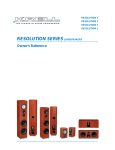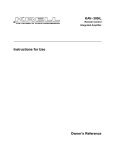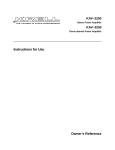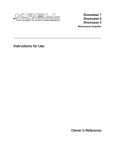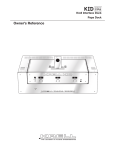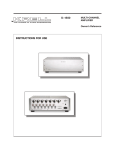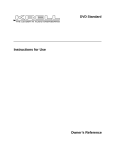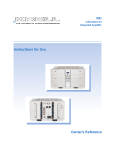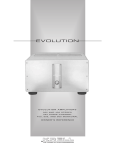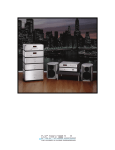Download Krell Industries Evolution 505 User's Manual
Transcript
EVOLUTION EVOLUTION SACD/CD OWNER’S 505 P L AY E R REFERENCE THE LEADER IN AUDIO ENGINEERING Evolution 505 SACD/CD Player Owner’s Reference, v06.0 Krell Industries, Inc. 45 Connair Road Orange, CT 06477-3650 USA TEL 203-298-4000 FAX 203-891-2028 E-MAIL [email protected] WEBSITE http://www.krellonline.com Go to website This product complies with the EMC directive (89/336/EEC) and the low-voltage directive (73/23/EEC). IMPORTANT SAFETY INSTRUCTIONS 1. Read Instructions. 2. Keep these Instructions. 3. Heed all Warnings. 4. Follow all Instructions. 5. Do not use this apparatus near water. 6. Clean only with dry cloth. 7. Do not install near any heat sources such as radiators, heat registers, stoves, or other apparatus (including amplifiers) that produce heat. 8. Unplug this apparatus during lightning storms or when unused for long periods of time. 9. Refer all servicing to qualified service personnel. Servicing is required when the apparatus has been damaged in any way, such as a power-supply cord or plug is damaged, liquid has been spilled or objects have fallen into the apparatus, the apparatus has been exposed to rain or moisture, does not operate normally, or has been dropped. 10. Caution: Visible and invisible laser radiation. When the cover is open, avoid exposure to the beam. This apparatus employs a laser. To prevent possible eye injury, only a qualified service person should remove the cover, or attempt to service this apparatus. Use of controls or adjustments or performance of procedures other than specified herein may result in hazardous laser radiation exposure. 11. The apparatus must be placed on a firm, level surface where it is not exposed to dripping or splashing. 12. The ventilation grids on the top of the apparatus and the space underneath it must be unobstructed at all times during operation. Do not place flammable material above or beneath the apparatus. 13. Before making connections to the Evolution 505, ensure that the power is off and other components are in mute or stand-by mode. Make sure all cable terminations are of the highest quality, free from frayed ends, short circuits, or cold solder joints. 14. THERE ARE NO USER SERVICEABLE PARTS INSIDE AN EVOLUTION 505 SACD/CD PLAYER. Please contact Krell if you have questions not addressed in this guide. This product is manufactured in the United States of America. Krell® is a registered trademark of Krell Industries, Inc., and is restricted for use by Krell Industries, Inc., its subsidiaries, and authorized agents. Evolution Bias™ is a trademark of Krell Industries, Inc. and is a Krell technology based on U.S. Patent No. 5,331,291. CAN Link™, CAST™, Evolution CAST™, and Krell Current Mode™ are trademarks of Krell Industries, Inc. All other trademarks are registered to their respective companies. © 2006 by Krell Industries, Inc. All rights reserved P/N 309405-W Contents List of Tables and Illustrations, page 4 A Letter from Dan D’Agostino, page 5 SECTION ONE: Evolution 505 Features and Technology, page 6 Features, Revolutionary Krell CAST Technology, Definition of Terms SECTION TWO: Unpacking and Placement, page 11 Opening the Evolution 505 Shipping Carton, Placement, AC Power Guidelines SECTION THREE: Anatomy of the Evolution 505, page 13 Front Panel Description, Remote Control Description, Battery Installation and Removal, Back Panel Description SECTION FOUR: Connecting the Evolution 505 to Your System, page 22 Using Balanced Connections, Connection Steps SECTION FIVE: Evolution 505 Operation, page 24 Power On, How to Play a Disc, Disc Formats, Data Disc, Filter, Repeat Functions, 12 VDC Trigger, RS-232 Port WARRANTY, page 28 RETURN AUTHORIZATION PROCEDURE, page 30 SPECIFICATIONS, page 31 3 List of Illustrations and Tables Figure 1, page 13 Evolution 505 Front Panel Figure 2, page 17 Evolution 505 Remote Control Figure 3, page 19 Evolution 505 Back Panel Table 1, page 22 Analog and Digital Connections 4 A Letter from Dan D’Agostino Dear Audio Enthusiast, Thank you for your purchase of the Krell Evolution 505 SACD/CD Player. Source components are the first, vital link in the audio signal chain, and an audio system can perform no better than the source allows. For this reason, I have made every effort to include the best technology in the design of this new Krell product. At the heart of the Evolution 505 are separate, linear power supplies that insure perfect operating conditions for the drive mechanism and audio circuits. Discrete, Class A gain stages are balanced and are utilized from input to output. Current Mode topologies enable wide bandwidth performance, while Current Audio Signal Transmission (CAST) transmitters insure the most robust connection to other Evolution components. All of these technologies are heard in the authentic and satisfying audio reproduction of the Evolution 505. I hope that you enjoy your new Evolution 505 source component. Sincerely, Daniel D’Agostino Chief Executive Officer 5 SECTION ONE Evolution 505 Features and Technology This section describes the innovative features and technology of the Evolution 505 SACD/CD Player, and defines CAST and other key terms used in this reference. The Evolution 505 works to carefully transmit audio signals without damaging the ephemeral staging and dimensional components of the music. A combination of advanced technologies and inspired design elevate the Evolution 505 SACD/CD Player’s performance to the reference level. Features The Evolution 505 has Class A, balanced, Krell Current Mode topology from input to output for increased bandwidth. New current mirror stages feature LED voltage reference. Developed for the Evolution Two, these current mirrors operate with three times less distortion than previous designs. A zero feedback design preserves the original harmonic structure of the recording, and a 500 K bandwidth promotes low distortion and phase coherent performance. The Evolution 505 uses PCM 1738 differential advanced segment DACs for superior dynamic range, and a DCI drive with independent suspension for enhanced ergonomics and reliability. The Evolution 505 will read redbook, CDR, 44.1 WAV, AAC (adts, and adif), DVDR, RW, +R, and RW discs. The 16 character, dot-matrix LED display is highly visible and features an adjustable intensity. For flexibility of control, the back panel features a 2-way, RS-232 interface, an RC-5 connector, and 12 VDC trigger inputs and outputs. Krell Can Link connectors allow the Evolution 505 to operate in link mode with other Evolution components. The outputs include balanced XLR, single-ended multi-channel outputs, and a pair of Evolution CAST™ outputs, for the most robust connection to other Evolution components. A 65 VA linear power supply is used for the drive mechanism, for absolute voltage stability. A separate 45 VA linear power supply for the audio circuits is optimized to power critical Class A audio topologies. 6 Revolutionary Krell CAST Technology Current Audio Signal Transmission, termed CAST, is a revolutionary method of connecting analog audio components for unparalleled sonic performance. Innovative engineering combines the new Krell CAST circuitry with existing Krell Current Mode technology to create entire CAST systems that reproduce music with incredible range, tonality, and precision. The Voltage Signal Transmission and the Traditional Audio System Traditionally, signal is transmitted in the voltage domain between two components. In an audio system, each component is a discrete entity with unique characteristics that act upon the musical signal independently. Each component is unaware of the other components in the system. The cables that connect the components also have their own electrical characteristics, which affect the sonic presentation of the entire system. CAST transmission unifies individual components and interconnects into an electrically-linked whole. The original signal remains unaltered from source to speaker. CAST Basics Here is how a CAST audio system works: Internally, each CAST source transfers, or amplifies, current using Krell Current Mode circuitry. This current signal is then output using CAST circuitry. When the signal is received by a CAST input, Krell Current Mode circuitry again takes over until the signal reaches the loudspeaker. By maintaining the musical signal in the current domain from beginning to end, an entire CAST system behaves as if it is one component. With CAST, circuit board properties and signal transmission aberrations between components are eliminated. Cable impedances and their effects on the transmitted signal are non-existent. How CAST and Krell Current Mode Interact While CAST is a new method of transferring the musical signal between components, its origin stems from Krell Current Mode, the technology developed to transfer the musical signal within a component. CAST combined with Krell Current Mode takes circuitry signal transmission to the next evolutionary level. 7 continued (SECTION ONE: Evolution 505 Features and Technology continued) In essence, Krell Current Mode maintains the integrity of the signal within the component and CAST preserves the transmitted signal between components. Together, CAST and Krell Current Mode technologies unify separate Krell components into a single global circuit. Krell Current Mode technology enjoys bandwidth increases up to an order of magnitude greater than their voltage based counterparts. This dramatic increase in circuit bandwidth delivers near perfection in the audible band that typically suffers from phase distortions in voltage circuits. CAST Cable Construction A CAST system uses cables manufactured by Krell and other manufacturers specially licensed by Krell. Thin and flexible CAST cables are constructed with the same build quality as other Krell components and are aesthetically matched to the components that Krell manufactures. An all-metal body and locking connectors with gold contacts are part of the standard no-compromise specification developed for every CAST cable made. Evolution CAST By employing radical current mirror circuitry, the Evolution 505 components elevate the CAST technology to another level. This advanced use of the technology increases the linearity, transient speed, and bandwidth of the Evolution components while reducing the distortion by an order of magnitude. The Best Musical Performance When you operate a CAST system, you will hear significant improvements in every performance area: speed, precision, dynamic range, depth and width of the sound stage, transient impact, tonal balance, harmonic distortion, and more. The goal for CAST is the same company goal used for all Krell products. Krell strives for the delivery of the best performance of a musical event for you, using the full expression of technology to date. 8 Definition of Terms The following are definitions of key terms used in this owner’s reference: Inputs and Outputs Balanced A symmetrical input or output circuit that has equal impedance from both input terminals to a common ground reference point. The industry standard for professional and sound recording installations, balanced connections have 6 dB more gain than single-ended connections and allow the use of long interconnect cables. Balanced connections are completely immune to induced noise from the system or the environment. CAST and Evolution CAST Krell Current Audio Signal Transmission, or CAST, is a proprietary Krell circuit technology for connecting analog components, transmitting the audio waveform between components in the current domain rather than in the voltage domain. The speed and bandwidth provided by Krell CAST and its circuitry update, Evolution CAST, yield accurate, realistic music reproduction, enabling connected components to perform as if they are all part of a single circuit. Single-ended A two-wire input or output circuit. Single-ended connections are not recommended for connections requiring long cable runs. Use care when using single-ended connections, because the ground connection is made last and broken first. Turn the system off/on prior to making or breaking single-ended connections. Operation Off When the back panel power switch (34) is in the down (0) position, or the AC power supply cord is disconnected, the component is off, and the stand-by/power LED is not illuminated. Stand-by A low-power-consumption status that keeps the audio and regulator circuits at idle. The stand-by/power LED (2) is illuminated in red when the component is in stand-by mode. Krell recommends leaving the component in stand-by mode when it is not playing music. Operation When the power button (1) or key is pressed, the standby/power LED (2) is illuminated in blue, and the component is in operational mode and ready to play music. 9 continued (SECTION ONE: Evolution 505 Features and Technology continued) Technology Krell Current Mode A proprietary Krell circuit topology in which the audio gain stages of a component operate in the current rather than the voltage domain. This unique technology provides the component with exceptional speed and a wide bandwidth. SACD Disc A Super Audio Compact Disc (SACD) is an audio disc that provides exceptional high quality sound. Based on the new Direct Stream Digital (DSD) technology, a format that comprises a 1-bit system, a SACD has a sampling frequency 64 times higher than that of a conventional audio CD. With a frequency response of over 50 kHz, and a dynamic range of 120 dB over the entire audible spectrum, the results are spectacular: There is no better audio disc reproduction. You will recognize a SACD by the super audio compact disc logo. There are three SACD disc types: 1. A single layer disc consists of one high density (HD) layer. 2. A dual layer disc consists of two HD layers, and can store twice as much information as a single layer disc. 3. A hybrid disc consists of one standard compact disc layer with conventional two-channel audio compact disc information, and one HD layer. SACD Disc: Hybrid Disc Type Each SACD disc type may contain two areas of recorded information: a high-quality two-channel area and a high-quality multi-channel area. Recorded information may vary per area. Refer to the disc inlay for more information. The hybrid SACD disc type has the most versatile disc playback options, with two areas of recorded information for SACD playback as well as backward compatibility with existing standard CD and DVD players via the standard compact disc layer. On a hybrid SACD disc, the two layers are read from the same side of the disc. The HD layer is read by a DVD laser. The reflective conventional compact disc layer is read by the CD laser through the second, semi-transmissive HD layer. CDDA This is the digital audio file type utilized for standard CD’s. CDDA stands for a Compact Disc Digital Audio system. Data Disc This is a disc composed of digital audio files of a type other than CDDA. The most widely recognized non-CDDA digital audio file type is MP3. 10 TWO SECTION Unpacking and Placement This section describes the procedures for safely unpacking and placing your Evolution 505 SACD/CD Player. The Evolution 505 is shipped in 1 carton consisting of the SACD/CD Player and an accessory box. Opening the Evolution 505 Shipping Carton The Evolution 505 shipping carton measures 22 in. (55.9 cm) wide by 12 in. (30.5 cm) high by 22 in. (55.9 cm) deep. Evolution 505 Chassis. This measures 17.3 in. (43.8 cm) wide by 6 in. (15.3 cm) high by 17.3 in. (43.8 cm) deep, and weighs 29 lbs. (13.2 kg). To Remove the Evolution 505 from the Shipping Carton 1. Open the shipping carton and open the top flaps. The carton contains these items: 1 Evolution 505 SACD Player 1 Accessory box containing the following: 1 IEC Connector (AC Power) cord 1 12 VDC (12 V trigger) cable 1 Remote control 2 AAA-size 1.5 Volt batteries for the remote 1 T-10 Torx wrench for the remote control 1 Packet containing the Quick Setup Guide and the Warranty Registration Card 2. Remove the accessory box and place to one side. 3. Lift out the removable front piece of foam. 4. Carefully lift out the Evolution 505 SACD/CD Player. It is quite heavy, so get a firm grip on it before lifting, or ask a friend to help. 5. Place the Evolution 505 in a safe location, and remove the protective plastic wrapping. Notes If any of these items are not included in the shipping box, please contact your authorized Krell dealer, distributor, or Krell for assistance. Save all packing materials. If you ship your Evolution 505 in the future, repack the unit in its original packaging to prevent transit damage. See Return Authorization Procedure, on page 30, for more information. 11 continued (SECTION TWO: Unpacking and Placement continued) Placement Before you install an Evolution 505 into your system, please follow the guidelines in this section to select a location for your component. This will facilitate a clean, trouble-free installation. The Evolution 505 does not require a special rack or cabinet for installation. The preamplifier chassis measures 17.3 in. (43.8 cm) wide, 6 in. (15.3 cm) high, and 17.3 in. (43.8 cm) deep. Place the Evolution 505 on a firm, level surface, away from excessive heat, humidity or moisture. The Evolution 505 requires at least two inches (5 cm) of clearance on each side, and at least two inches (5 cm) of clearance above the component to provide adequate ventilation. Installation inside cabinetry may require additional ventilation. Do not place the Evolution 505 near hum sensitive components such as preamplifier phono stages or turntables. Although the Evolution 505 is well shielded, placing it near these components could create interference and cause hum. Note The Evolution 505 incorporates an advanced suspension system and does not require additional mass coupling or isolation. You may experiment with feet or cones as long as they are not permanently affixed to the unit. Any unauthorized modifications to the unit or electronics will void the warranty. IMPORTANT Do not attach enhancement accessories such as rings, mats, or dampers to individual discs. These accessories may interfere with the disc transport, resulting in erratic playback and/or poor sound. AC Power Guidelines The Evolution 505 has superb regulation and does not require a dedicated AC circuit. Avoid connections through extension cords or multiple AC adapters. High quality 15 amp AC strips are acceptable. The use of AC line conditioning devices or filters may be used if they are grounded and meet or exceed the unit’s power supply rating of 100 VA. IMPORTANT When the internal line fuse needs to be replaced, contact your dealer, distributor or Krell. The line fuse is not intended to be replaced by the user. 12 SECTION THREE Anatomy of the Evolution 505 This section describes the Evolution 505 functions. Figure 1 Evolution 505 Front Panel Power Remote IR Transport Functions Menu Navigation Functions Filter CD Transport Display Functions Not Used 1 2 3 4 5 6 7 8 9 10 11 12 13 14 15 16 17 18 19 20 21 Power Button Stand-by/Power LED Infrared Sensor Pause Stop Play Open/Close Track Skip Search forward and back Menu Enter Menu Navigation Title Program Clear Direct Track Select Numbers Filter Select CD Transport Display Dim Display Select Setup and Disc 13 continued (SECTION THREE: Anatomy of the Evolution 505 continued) Front Panel Description Power, transport, and display features are described below (see Figure 1 on the previous page). Most front panel features can be activated using the remote control keys. Descriptions of special operational features are outlined on page 24. Power 1 Power Button or Key Use this button or key to switch the Evolution 505 between the stand-by and operational modes. 2 Stand-by/Power LED This LED illuminates red (stand-by) when the Evolution 505 is plugged into a standard live AC wall receptacle and the rear panel power switch is turned on. The LED will illuminate blue (operational mode) when the power button (1) or key is pressed while the Evolution 505 is in stand-by mode. Remote Functions on the Front Panel 3 Infrared Sensor The infrared sensor receives commands from the Evolution 505 remote control. For proper remote control operation, make sure the infrared sensor is not covered or obstructed. Transport Functions 4 Pause Button or Key Temporarily suspends playback of a track. To resume playback at the point pause was engaged, press play. 5 Stop Button or Key Stops disc playback. 6 Play Button or Key Starts playback from the beginning of the disc. See also How to Play a Disc, page 16. 7 Open/Close Button or Key Opens or closes the disc transport. 8 Track Skip Forward and Back Buttons or Keys Track forward selects the track that follows the current track. Track back selects the track that precedes the current track. Press repeatedly (do not hold) to skip multiple tracks. 9 Search Forward and Back Buttons or Keys Press and hold to scroll forward or backward in the current track. Press play to return to normal playback. 14 10 Menu Button or Key Accesses three menu choices: track number, disc mode, and sample rate. 11 Enter Button or Key Press to view track number, disc mode, and sample rate. 12 Menu Navigation Buttons or Keys Press the up or down arrows to navigate the three menu choices. 13 Title Button or Key Selects the format: conventional CD (CD), two-channel SACD (SACD STEREO), or multi-channel SACD (SACD MULTI). The default format is SACD MULTI. The currently selected format appears in the front panel display (19). 14 Prog Button or Key Press to begin programming a sequence of tracks. If a disc is playing, press stop (5) and then press prog. To set up a program: Press prog (14), then enter a track number using the Direct Track Access buttons (16) and press enter (11). Select another track and press enter, and repeat until all desired tracks are chosen. Press play (6) to begin the program. To stop the program: Press open/close (7) to open the transport, or press stop (5) once and prog twice. 15 Clear Button or Key Press to delete an unwanted entry in a program sequence. 16 Direct Track Access Buttons or Keys Buttons 0 through 9 access each track in a compact disc directly. If tracks consist of 2 digits, the buttons or keys must be pressed within 2 seconds of each other. 17 Filter Select Button or Key, and LEDs Select filter responses for all disc formats. The LED shows which filter is selected. See page 26 for more details. 18 Compact Disc Transport This holds the disc. Open and close it using the open/close button or key (7). 15 continued (SECTION THREE: Anatomy of the Evolution 505 continued) Display 19 Front Panel Display Shows disc type and format, and the current status of the Evolution 505. See page 27 for more details. 20 Dim Button or Key This reduces the brightness of the front panel display. 21 Display Button or Key This cycles the display between three choices: remaining track time, elapsed disc time, and remaining disc time. The following front panel buttons are not operational: setup and disc. 16 Figure 2 Evolution 505 Remote Control Power Transport Functions Menu Navigation Functions Filter Display Functions Repeat Functions Not Used 1 4 5 6 7 8 9 10 11 12 13 14 15 16 17 20 21 22 23 Power Button Pause Stop Play Open/Close Track Skip Search forward and back Menu Enter Menu Navigation Title Program Clear Direct Track Select Numbers Filter Select Dim Display Select Repeat (Remote Only) A/B Repeat (Remote Only) Setup, Disc, Subt, Angle, Ret 17 continued (SECTION THREE: Anatomy of the Evolution 505 continued) Remote Control Description See Figure 2 on the previous page The Evolution 505 remote control provides the same functions as the front panel. In addition, there are three keys that are unique to the remote control, and these are described below. 22 Repeat Key Replays selected track until new feature is selected. See also, Using the Repeat Key, on page 27. 23 Repeat A-B Key Creates a loop between two pre-determined points within a single track or sequential tracks. Press once to select the start of the repeat loop (A), and press again to select the end of the loop (B). See also, Using the Repeat A/B Key, on page 27. 24 Audio Key Cycles between the stereo and multi-channel layers of an SACD disc. The following remote control keys are not operational: setup, disc, subt, angle, and ret. Battery Installation and Removal The remote control uses 2 AAA-size 1.5 Volt batteries. Batteries are included with the shipment. To install the batteries: 1. Remove the remote control backplate, using the supplied T-10 Torx wrench. 2. Install the batteries, following the battery position diagram on the plastic battery receptacle. 3. Replace and secure the backplate. Note Replace batteries when remote control function becomes intermittent. Do not use a knife or other sharp object to remove the backplate, as this may damage the remote control finish. Remove batteries if the remote control is not used for a long period of time. Battery leakage can damage the remote control. 18 Figure 3 Evolution 505 Back Panel Analog Outputs Digital Outputs 12 V Trigger Remote IR Serial Port CAN Link AC Power Functions 25 26 28 29 30 31 33 32 27 34 35 Balanced Outputs Single-ended Outputs CAST Outputs Optical Digital Output Coaxial Digital Output 12 VDC (Trigger) In and Out RC-5 Input RS-232 Communication Port CAN Link Connectors AC Power Switch IEC Power Cord Receptacle 19 continued (SECTION THREE: Anatomy of the Evolution 505 continued) Back Panel Description See Figure 3 on the previous page The back panel provides all the output connections, remote control inputs and outputs, and the AC power connection. The back panel features are described below. Analog Audio Outputs 25 Balanced Outputs One pair of balanced outputs with XLR connectors. 26 Single-ended Outputs For connection to a multi-channel receiver, with unbalanced RCA connectors: L, R = left and right channel connections. C = center channel connection. SW = subwoofer connection. SL, SR = left and right surround channel connections. 28 CAST Outputs The Evolution 505 is equipped with two CAST outputs with 4-pin bayonet connectors, for use with Krell CAST-equipped preamplifiers. Digital Audio Outputs (CD format only) 29 Optical Digital Output One EIAJ fiber optical digital output with a TosLink connector. 30 Coaxial Digital Output One S/PDIF coaxial digital output with an RCA connector. 20 Remote Connections on the Back Panel 31 12 VDC (Trigger) In and Out The output sends 12 VDC power on/off signals to other Krell components and other devices that incorporate a 12 V trigger. The input receives 12 VDC power on/off signals from other components and devices that incorporate a 12 V trigger. 33 RC-5 Input The RC-5 remote connector is used with a third party remote control system that provides RC-5 (IR) data with the carrier intact, via a wired connection. A stereo tip, ring, sleeve 1/8-inch mini connector is used in the following configuration: Tip = RC-5 data, Ring = +5 V, Sleeve = GND. 27 CAN Link These RJ-45 link connectors are connected in parallel. They are used to connect the Evolution 505 in link mode, to other CAN Link-enabled Krell products. 32 RS-232 Communication Port This port allows you to send operational instructions to the Evolution 505 using an external computer control system. The RS-232 port uses a 9-pin D-subminiature connector. Power 34 AC Power Switch Use this switch to change the Evolution 505 from off to stand-by. 35 IEC Power Cord Receptacle Use the provided IEC standard 15 amp power cord. 21 SECTION FOUR Connecting the Evolution 505 to Your System Using Balanced Connections Krell recommends using balanced interconnect cables. Balanced interconnect cables can not only minimize sonic loss, but are also immune to induced noise, especially with installations using long cables. Balanced connections have 6 dB more gain than single-ended connections. When level matching is critical, keep this gain value in mind. Table 1 Analog and Digital Connections CD Format Analog Output Balanced Single-ended L+R MULTI Digital Output Optical Coaxial Conventional CD YES YES NO YES YES Two-channel SACD YES YES NO NO NO Multi-channel SACD YES YES YES NO NO 22 Connection Steps Follow these steps to connect the Evolution 505 to your system. 1. Make sure all power sources and components are off before connecting inputs and outputs. 2. Neatly organize the wiring between the Evolution 505 and all system components. Separate AC wires from audio cables to prevent hum or other unwanted noises from being introduced into the system. 3. Remember that balanced outputs use three-pin XLR connectors. Single-ended outputs use RCA connectors. Maintain the correct left/right orientation of these outputs. 4. To play an SACD, you need to use the analog audio outputs. Digital audio outputs are only available for conventional compact discs. For multi-channel SACD (SACD MULTI), two-channel SACD (SACD STEREO), and conventional compact disc playback, connect the Evolution 505 multi-channel analog audio outputs to the surround preamp/processor multi-channel inputs. All multi-channel analog audio outputs are available in the SACD MULTI format. The center (C), subwoofer (SW) and surround (SL, SR) multi-channel outputs are not available in the CD or SACD formats. The left (L) and right (R) multichannel outputs are always active. 5. For two-channel and conventional compact disc playback only, connect the Evolution 505 balanced analog audio outputs or the left (L) and right (R) multichannel outputs to the preamplifier balanced or single-ended analog audio inputs. 6. For conventional compact disc playback only, connect the Evolution 505 digital coaxial output or digital optics output to the corresponding preamp/processor digital input. 7. Plug the AC power cord into the IEC power connector on the back panel. Then plug the AC power cord into the wall socket. 23 SECTION FIVE Evolution 505 Operation This section provides information about operating the Evolution 505. See Front Panel /Remote Control Description, on pages 13-21, for more Evolution 505 playback features. Power On Press the back panel power switch (34) labeled “1”. When the Evolution 505 is initialized and in the stand-by mode, the red stand-by LED (2) on the front panel illuminates. Then press the power button (1) on the front panel or the power key on the remote control, to place the Evolution 505 in the operational mode. When the blue stand-by LED (2) illuminates, the Evolution 505 is in the operational mode and ready to play a SACD or a conventional compact disc. How to Play a Disc 1. Press the open/close button (7) or key, to open the disc transport. 2. Place the disc on the transport. 3. Press the open/close button or key again to close the disc transport. The front panel display reads the total tracks and time on the disc. 4. Press the play button (6) or key. The format type is seen in the front panel display. The format type disappears, and the front panel display reads TRACK 1 and the track time as the disc begins playing. 5. Press the stop button (5) or key, and then the title button (13) or key in order to select another disc format and view available tracks. 6. Adjust the volume level through your system volume control. 7. Press the stop button or key to end disc playback. 8. Press the play button or key to begin playback again, from the first track. 9. To return the Evolution 505 to the stand-by mode, press the power button (1) or key. 24 Using the Title Button or Key (13) Use the title button (13) or key to select one of the three disc formats that the Evolution 505 plays: CD (conventional CD), SACD STEREO (two-channel SACD) and SACD MULTI (multi-channel SACD). The currently selected format is shown in the front panel display (18). The default format for all SACD discs is SACD MULTI. The tracks on the selected disc format are the only tracks that can be played. To access tracks on alternate disc format, press the title button or key again. If there are no tracks in a particular format, that format does not appear in the front panel display. Perform the following steps in order to access the different formats on a hybrid SACD: 1. Press the stop button (5) or key. The front panel display reads the total tracks and time on the disc. 2. Press the title button (13) or key until the desired format is seen in the front panel display. The format name disappears and the front panel display reads the total tracks and time on the disc. Press the play (6) button or key to begin playing the selected format. Note The front panel display reads “CHANGING LAYER” whenever you move between the conventional CD and SACD layers. Navigating a Data Disc The Evolution 505 is capable of reading MP3 audio files from data discs that you prepare on a personal computer. The front panel display indicates ROOT when you are at the beginning of the disc, F corresponds to a closed folder, and TOP designates an open folder. Use the following buttons and keys to navigate within a data disc: 1. Press the enter button (11) or key to open a folder or move back to a previous folder, or to play a track. 2. Press the up and down arrow buttons (12) or keys to move among tracks in a folder. 25 continued (SECTION FIVE: Evolution 505 Operation continued) Using the Filter Button or Key (17) Four filters make subtle changes to the high frequencies at ultrasonic levels, altering the sonic presentation from your loudspeakers. Once a filter setting has been selected, it is held in memory even if the Evolution 505 is turned off and then returned to operational status. Filter 1, 2, 3, and 4 are available in any SACD format. Only Filters 1 and 2 are available in the conventional CD format. All filters have a different output gain, higher bandwidth, and a more gradual rolloff in the SACD format, compared to Filter 1 and 2 in the CD format. Filter 1 and 2 are designed to eliminate aliasing artifacts that are the result of the D/A re-construction process. Conventional Compact Disc Format Filters Filter 1 operates flat from 20 Hz to 20 kHz, with a very steep roll-off characteristic above 20 kHz (21.5 kHz, -3 dB). Filter 2 operates up to 20 kHz (-3 dB) with a more gradual roll-off characteristic when compared to Filter 1. SACD Format Filters Filter 1 in the SACD format, has the same relative output gain as Filter 1 and 2 in the CD format, and it has the highest bandwidth of the four SACD filters. Filters 2, 3 and 4 in the SACD format, operate at reduced bandwidth with steeper slope filtering and different output gain. Filter 1 operates up to 180 kHz (highest bandwidth) and has the slowest roll-off characteristic with no change in output gain. Filter 2 operates up to 75 kHz and has the steepest roll-off characteristic. It has a +0.5 dB increase in output gain over the entire audio pass band compared to Filter 1. Filter 3 operates up to 80 kHz and has the 2nd steepest roll-off characteristic. It has a +5.5 dB increase in output gain over the entire audio pass band compared to Filter 1. Filter 4 operates up to 90 kHz and has the 3rd steepest roll-off characteristic. It has a +3.5 dB increase in output gain over the entire audio pass band compared to Filter 1. 26 Using the Repeat Key (22) Press the repeat key once to repeat the current track. The front panel display (19) reads REPEAT SINGLE. Press the repeat key twice to repeat the whole disc. The front panel display reads REPEAT ALL. Press the repeat key a third time to cancel this function. Using the Repeat A/B Key (23) To create an A/B loop, start by playing a track. When you hear the part that you want as the beginning of the loop, press A/B to insert the start position. Press A/B again to insert the finish position. A/B playback will automatically begin and will continue indefinitely. To delete, press A/B again, or press the stop button (5) or key. Using the Front Panel Display (19) The front panel display shows the disc type, the elapsed time of the track, and the feature that has been selected, for example: REPEAT ALL or REPEAT SINGLE. Press the display button (21) or key to show track time remaining, disc elapsed time, or disc time remaining. Press the dim button (20) or key to reduce the brightness of the display. Using the 12 V Trigger (31) This function allows you to turn other components on or off, or to and from standby, from the Evolution 505. When the Evolution 505 is switched between stand-by and the operational mode, the 12 V trigger sends a signal from the 12 VDC Out that will switch other components, allowing whole systems or parts of systems to be easily coordinated. The 12 VDC input allows you to turn the Evolution 505 on or off, or to and from stand-by, from other components. Note When the component is in the operational mode, the 12 VDC Out provides 12 V of DC output. When the component is in the stand-by mode or off, the DC output is 0 V. The 12 VDC output current is limited to 30 mA. Consult the owner’s reference of the components used in a custom installation to take full advantage of the remote capability of the Evolution 505. Using the RS-232 Port (32) For more information on using the RS-232 communications port, see RS-232 Port: Sending Commands and Interpreting Data, the developer’s reference for the Evolution 505. 27 Warranty Krell products have a limited warranty. Amplifiers, preamplifiers, preamp/processors, and receivers carry a limited warranty of five years for parts and labor on circuitry. Loudspeakers carry a limited warranty of five years for parts and labor. CD and DVD players carry a limited warranty of five years for parts and labor on circuitry, and three years for parts and labor on mechanical parts. Should the product fail to perform at any time during the warranty, Krell will repair it at no cost to the owner, except as set forth in this warranty. This warranty does not apply to damage caused by acts of God or nature. This warranty shall be in lieu of any other warranty, expressed or implied, including, but not limited to, any implied warranty of merchantability or fitness for a particular purpose. There are no warranties which exceed beyond those described in this document, if the product does not perform as warranted herein, the owner’s sole remedy shall be repair. In no event will Krell be liable for incidental or consequential damages arising from purchase, use, or inability to use the product, even if Krell has been advised of the possibility of such damages. Proof of purchase in the form of a bill of sale or receipted invoice substantiating that the product is within the warranty period must be presented to obtain warranty service. The warranty begins on the date of the original retail purchase, as noted on the bill of sale or receipted invoice from an authorized Krell dealer or distributor. Previously owned equipment, when re-purchased from an authorized Krell dealer or distributor, has the balance of the original warranty, based on the original date of manufacture. The warranty for a Krell product is valid only in the country to which it was originally shipped, through the authorized Krell distributor for that country, and at the factory. There may be restrictions on or changes to Krell’s warranty because of regulations within a specific country. Please check with your distributor for a complete understanding of the warranty in your country. If the product is serviced by a distributor who did not import the unit, there may be a charge for service, even if the product is within the warranty period. Freight to the factory is your responsibility. Return freight within the United States (U.S.A.) is included in the warranty. If you have purchased your Krell product outside the U.S.A. and wish to have it serviced at the factory, all freight and associated charges to the factory are your responsibility. Krell will pay return freight to the U.S.A.-based freight forwarder of your choice. Freight and other charges to ship the product from the freight forwarder to you are also your responsibility. 28 Krell is not responsible for any damage incurred in transit. Krell will file claims for damages as necessary for a product damaged in transit to the factory. You are responsible for filing claims for shipping damages during the return shipment. Krell does not supply replacement parts and/or products to the owner of the product. Replacement parts and/or products will be furnished only to the distributor performing service on this product on an exchange basis only; any parts and/or products returned to Krell for exchange become the property of Krell. No expressed or implied warranty is made for any Krell product damaged by accident, abuse, misuse, natural or personal disaster, or unauthorized modification. Any unauthorized voltage conversion, disassembly, component replacement, perforation of chassis, updates, or modifications performed to the product will void the warranty. The operating voltage of the product is determined by the factory and can only be changed by an authorized Krell distributor or at the factory. The voltage for this product in the U.S.A. cannot be changed until six months from the original purchase date. In the event that Krell receives a product for warranty service that has been modified in any way without Krell authorization, all warranties on that product will be void. The product will be returned to original factory layout specifications at the owner’s expense before it is repaired. All repairs required after the product has been returned to original factory specifications will be charged to the customer, at current parts and labor rates. All operational features, functions, and specifications and policies are subject to change without notification. To register your product for warranty benefits, please complete and return the Warranty Registration Card enclosed in the shipping box within 15 days of purchase. Thank you. 29 Return Authorization Procedure If you believe there is a problem with your component, please contact your dealer, distributor, or the Krell factory to discuss the problem before you return the component for repair. To expedite service, you may wish to complete and e-mail the Service Request Form in the Service Section of our website at: http://www.krellonline.com To contact the Krell Service Department TEL 203-298-4020, Monday-Friday 9:00 AM to 5:00 PM EST FAX 203-795-2287 E-MAIL [email protected] WEBSITE http://www.krellonline.com Evolution 505 PRODUCT MODEL NUMBER SERIAL NUMBER To return a product to Krell, please follow this procedure so that we may serve you better. 1. Obtain a Return Authorization Number (R/A number) and shipping address from the Krell Service Department. 2. Insure and accept all liability for loss or damage to the product during ship ment to the Krell factory and ensure all freight (shipping) charges are prepaid. The product may also be hand delivered if arrangements with the Service Department have been made in advance. Proof of purchase will be required for warranty validation at the time of hand delivery. IMPORTANT Use the original packaging to ensure the safe transit of the product to the factory, dealer, or distributor. Krell may, at its discretion, return a product in new packaging and bill the owner for such packaging if the product received by Krell was boxed in nonstandard packaging or if the original packaging was so damaged that it was unusable. If Krell determines that new packaging is required, the owner will be notified before the product is returned. To purchase additional packaging, please contact your authorized Krell dealer, distributor, or the Krell Service Department for assistance. 30 Specifications Frequency response 20 Hz to 20 kHz +0.0, -0.5 dB Signal to noise ratio “A” weighted 105 dB THD 20 Hz to 20 kHz, -82 dB Power Consumption 61 W Analog Audio outputs 1 pr. CAST via 4-pin bayonet connectors 1 pr. balanced via XLR connector 6 single-ended via RCA connector Digital Audio outputs 1 S/PDIF via RCA, 1 EIAJ optical via TosLink Remote Control 1 Wireless IR Remote 1 Remote IR sensor input via a 3-conductor 3.5 mm connector Control inputs 1 RS-232 port via a 9-pin D-subminiature connector 1 12 VDC trigger input via 3.5 mm connector 1 Krell CAN Link via an RJ-45 connector Control outputs 1 12 VDC trigger output via 3.5 mm connectors 1 Krell CAN Link via an RJ-45 connector Dimensions 17.3 in. W x 6 in. H x 17.3 in. D 43.8 cm W x 15.3 cm H x 43.8 cm D Weight Shipped: 37 lbs., 16.8 kg Unit only: 29 lbs., 13.2 kg Note All operational features, functions, specifications, and policies are subject to change with out notification. 31 EVOLUTION SACD/CD OWNER’S 505 P L AY E R REFERENCE V06.0 KRELL 45 INDUSTRIES, CONNAIR ORANGE, TEL: CT 203-298-4000 E-MAIL: INC. ROAD 06477-3650 • FA X : USA 203-891-2028 [email protected] h t t p : / / w w w. k r e l l o n l i n e . c o m

































